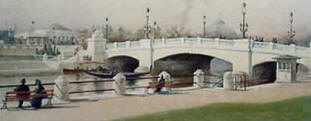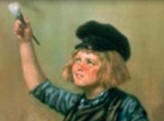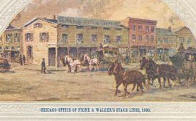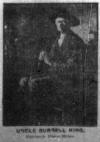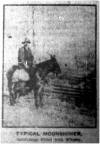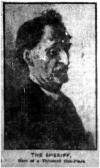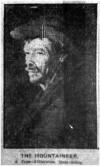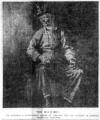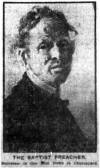It is a fact that we learn from schoolbooks that the geographical conditions of
a country, and its physical features exert much influence, favorable or otherwise, on the
civilization of its people.
This is quite certainly the reason why the Kentucky mountaineers, which Lawrence
Earle, the artist, describes so interestingly by word as well as by brush, are such a
backward, unambitious lot.
Mr. Earle, whose studio is in the Burleson, spent several months this spring and
summer in the southeastern part of Kentucky, studying the natives and painting the
different types of these mountain folk.
"I wish I were a novelist, or had had a stenographer with me," said
Mr. Earle. "Those people are an interesting lot, and offer great types to study. They
provide a great field for the writer. I wished I might have taken down some of their
quaint conversations and discussions." These are the folk that John Fox, Jr., has
portrayed so vividly in his "Little Shepherd of Kingdom Come" and other
writings, which run in a vein of sympathy and humor that indicate the novelist has
succeeded in getting into the life of the Kentuckians.
But Mr. Earle need have no regret that he cannot convey to others the
impressions this strange people made on him. Quite as successfully as the author, the
artist, in his own way, tells the simple story of these mountaineers. His brush has done
its work well. Sometimes the strokes are sad ones as they lay on canvas the tragic
hopelessness of these people. Again, the oils are laid with a gayer movement, as the
artist attempts to communicate the subtle humor of the backwoods folk. Indeed, he has
caught nicely both the tragic and the comic of the situation, and shows us the Kentuckian
of the mountain as he really is, an unambitious, for the most part, shiftless stock, who
accepts his hopeless lot carelessly; whose concern never extends beyond the corn and
potatoes for dinner, who is full of hospitality, is quick to pull a gun at fancied insult;
who despite his lethargy, is full of good stuff, that needs but to awaken to prove itself
the equal of the more industrious types.
The Grand Rapids artist brought with him a number of canvasses on which he
painted these people. They present a fascinating study and take on additional charm as one
hears from the lips of the artist the personalities of the subjects. He has chosen the
common types for his sittings. He has caught the grimness of the sheriff, the hero of a
thousand gun-plays; the listlessness of the mountaineer who languishes in the cabin
doorway; the pathos of the mine boy, stunted, stooped, plodding; the suspicious mountain
youth schooled in wariness.
It was on the Stearns estate, that embraces 119,000 acres in the southeast part
of the state, that Mr. Earle roamed from April till July, often hours at a time in the
saddle, sometimes far up the mountain sides, following the devious course of treacherous
paths where a miss of the animal would have plunged both far down the sides.
The tract is owned by the Stearns of Ludington, the great lumber firm. Mr. Earle
was the guest of his friend, Robert L. Stearns, the son
of the elder, well known lumberman, Justus Stearns. The artist planned to stay two weeks,
but the country got its grip on him, and he lingered on several months. The holding is
rich in coal deposits, 11 mines now being operated by the firm. There is a great
wealth of
forest also, which up to the present has been practically unexplored.
The little town of Stearns lying over on the Tennessee line, was
the artist's stopping place, and from there he rode far out over the hills
to study the people. His subjects were treated to a new experience. Hardly
a one of them ever heard of an artist before and they exhibited all their
native suspicion in their attitude to his approaches. It was only through
the good efforts of Mr. Stearns, who is the big man of the region and
whose word goes, that the natives were prevailed upon to make
the sittings.
The people had no conception of the task of the artist, and no idea what
the worth of the portrait was. It was while Mr. Earle was painting a mine boy, begrimed
with dirt, just as he was called from his task, that the interested father, exhibiting a
stray bit of ambition, asked the artist how long it took to learn to do such
"printing." He thought it might be a good thing for his boy to pick it up, and
supposed it but the effort of a few weeks to master the occupation.
It should not be forgotten that it was from such stock as this that Lincoln
sprung, and that his birthplace was in the mountains of Kentucky. When one remembers the
rugged worth of this great man, he better appreciates the sterling qualities that
occasionally are rubbed to the surface in this region. John Fox, Jr., too, has shown that
the mountains contain great characters, some of whom he has writ large in the pages of his
books.
Yet it is true that these people, for the most part, are decidedly
non-progressive, a hundred years behind civilization. They think as their grandfathers
thought, they work as their forerunners did, with the same tools, with the same
indifference. They live in the same cabins, nurse the same grievances, shoot as deadly,
talk as unintelligently. The great wave of progress that has swept westward seemingly has
parted at this point, leaving these mountain fastnesses untouched by the enlightening
power of modernism.
These mountaineers raise large families and small patches of corn and potatoes.
Few families number less than nine or ten, and the boys and girls are as listless, as easy
going as the parents. They grow up in the spirit of their fathers, inherit the same feuds,
live out their lives untouched by better things, unless cut off suddenly by a bullet from
some clump of bushes.
Shooting of a Preacher
Mr. Earle tells the story of the Baptist minister whose congregation was divided
on his worth. Some of the mountaineers thought him a good preacher, others were of a
different mind. One Sunday morning, after an unusually warm service, featured by the
wrangles of the disagreeing members, the minister was shot down by one of the
"off" faction. It was looked upon as the easiest way to settle the point.
One member volunteered that that seemed rather a harsh way of treating the
preacher, but another declared that he didn't see how, for the preacher was only getting
the just reward he had been preaching about to them. His successor was the subject of a
sitting, and the artist also painted the son of the murdered preacher. The lad sat with
the greatest reluctance, and eyed Mr. Earle through the work. The artist succeeded well in
catching the innate suspicion written large in the lad's features.
After some persuasion the artist got Uncle Burrell King, the patriarch of the
region, to sit for a couple hours. King is 87 years old and has passed his whole life in
the mountains. He is absolutely ignorant in some matters, can neither read nor write and
knows little of civil matters. Yet he is the peacemaker of the mountains, and is known far
and wide about that country. He has settled more feuds than any other man around those
parts and is usually sent for when matters reach a crisis, though not infrequently he
finds upon arrival the restless trigger anger of some aroused mountaineer has anticipated
him. Strange enough, the old man himself never uses a gun. He shares a certain kind of
ammunition, however. Mr. Earle snapped the bottle of whiskey in one picture he took of the
old fellow.
The Moonshiners
Moonshine, by the way, features these parts. Scattered here and there along the
mountain trails, usually secluded in a measure behind some wooded growth, are the blind
jacks. Incorporating the same principle as the Michigan blind pigs. Little wooden shacks,
devoid of windows and doors, are they. At the front is one small opening, with a wood
slide that fills the aperture. Patronizing one of the jacks is a precarious business in
itself. One must give a certain rap, at which a voice from the interior raises the
question. Then the thirsty soul tells his wants, shoves in the coin, and the
moonshine is thrust out. No person is seen, hence it is somewhat difficult to
secure convicting evidence. If one's curiosity prompts him to step around to
the rear, he is brought up sharply at the point of a gun, and is indeed
fortunate if his inquisitiveness does not cost him his life.
The
moonshine, says Mr. Earle, is pretty rank liquor. He doesn't see how
anyone would care to drink the rotten stuff even if it were had for the
asking. In this connection the artist hasn't much to say in favor of
the Kentucky cooking as found either in cabins or the hotels of the
town. Somerset is the county west of Pulaski county, near where the
Stearns holdings lie, and the artist is frank to say that the hotel in
that town of 6,000 is absolutely the worst he was ever in. He
wanted to stick out three meals there, but left after the second, half
sick over the table fare. "They don't know how to cook," he declared.
Still Remember the War
It is not strange when one learns the character of the people and their
insolated lives, to find that the resentments engendered by the war are still harbored. In
this region, all practically were unionists, and the old spirit flames easily even today,
where in the more enlightened communities, feeling has been buried. One way, and a most
effective means, that the mountaineers have of demonstrating their hatred of the
confederate is in the courtroom. The rulings of the court, the ethics of the case, the
actual facts of the matter, stand no show against the feelings of a mountaineer jury when
a man of southern sympathies is on trial. Almost invariably he gets the worst verdict the
jury finds in its power to return. Mr. Earle declares, however, that the lawyers of that
section are eloquent pleaders, inheriting in a generous measure the eloquence of the
Kentucky statesmen who have gone down in American history.
Mr. Earle says that one of the greatest educative forces in that region today is
the moving picture show. While that form of entertainment is being questioned in the north
as to its worth, it is proving the agency of civilization in the mountains. Somehow these
shows get a grip on these simple folks who are fascinated by them. The boy or girl way up
in the mountains will rouse himself enough to spend a whole day on the slopes picking
berries, which are carried miles to town at night, and sold, the proceeds to purchase the
ticket to the show. The people there think nothing of walking miles down the mountain
paths to these shows, which are crowded nightly. Here these people get their first glimpse
of the world outside and not infrequently does it waken desire that leads them to better
themselves to bigger things.
But one must really see the portraits to catch the real spirit of these Kentucky
folk. Mr. Earle has produced some remarkable studies, which he exhibits in his studio. Mr.
Earle, by the way, is the first artist of Grand Rapids, one to whom the city can properly
lay claim as its own. He came here as a lad from New York with his father in 1858, and in
1869 went to Chicago, where he studied and later opened a studio. After 20 years there, he
went back to New York, where, after an equal length of time, he closed his studio to
return to Grand Rapids. He has been here somewhat over a year.
Included with the newspaper article are
photos with the following captions:
- The Mine Boy
- The Sheriff
- The Baptist Preacher
- The Mountaineer
- Typical Moonshiner
- Uncle Burrell King
